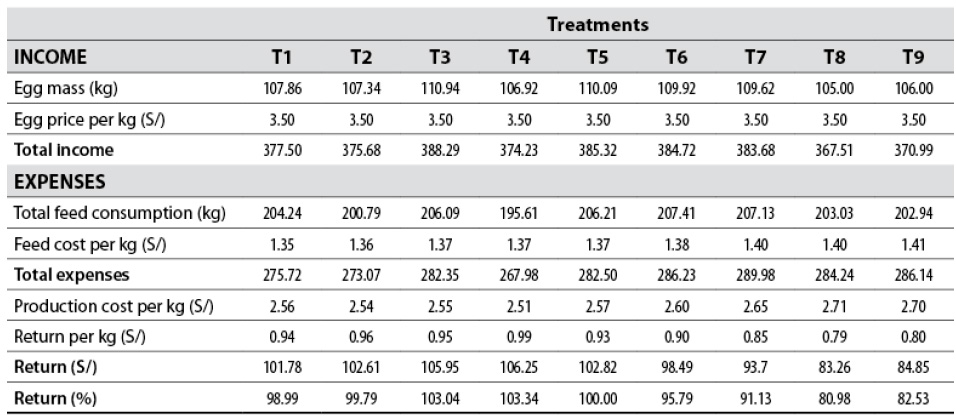Introduction
In poultry production systems, feed represents between 70 and 80% of production costs; energy, protein, and amino acids are limiting factors that significantly affect the poultry industry’s feed costs and performance (Cancherini et al., 2005). The availability of the synthetic amino acids methionine and lysine in poultry feeds allowed lower protein levels since these amino acids limit portions for chickens and hens (Ramírez & Gonzalez, 1992).
In layers, methionine is the first limiting amino acid, followed by lysine in corn-soybean diets (Nicodemus et al., 2011) with significant influence on egg size and weight (Barbosa et al., 2009). It is then vital to establish methionine and cystine requirements in the diet (Joly, 2008). Choosing the appropriate protein level will have to be favorable both for the bird, which will potentiate its metabolic functions, and for the producer, who will maximize its financial resources by saving protein sources (Barros et al., 2006). However, decreasing the protein level in the diet can result in reduced consumption and egg production (Peganova & Eder, 2003).
Birds do not require a high intake of crude protein (CP), but its quality should ensure a nitrogen reserve to synthesize non-essential amino acids (Gallardo et al., 2014). Regarding the methionine + cystine requirement levels, at least 55% of sulfur amino acids present are methionine, and the remainder is cystine (D’Agostini, 2005). According to Saki et al. (2012), raising the methionine level from 0.24 to 0.34% increases egg production, weight, mass, content, and feed consumption while decreasing feed conversion. Nevertheless, the information available on digestible methionine + cystine nutritional requirements in light and mid-heavy commercial layers is scarce (D’Agostini et al., 2017). For these animals, the adjustment of the protein and amino acid levels in the diet is essential due to the great demand for these nutrients to synthesize egg, albumen, and yolk (Gambaro, 2014).
Moreover, Da Silva et al. (2014) evaluated the effect of protein reduction in layers between 24 and 40 weeks of age, recommending a CP level of 16% not to harm production efficiency and egg quality. Regarding amino acid levels, Brumano (2008) tested six methionine + cystine levels (0.65, 0.70, 0.75, 0.80, 0.85, and 0.90%) in hens between 24 and 40 weeks of age, recommending 0.77% and daily consumption of 682 mg/bird/day of these amino acids. When evaluating the performance of light layers between 25 and 33 weeks of age subjected to different CP levels (18.5, 17.5, 16.5, and 15.5%), Mousavi et al. (2013) observed a reduction in egg weight and mass when the protein level decreased by 3 and 1% respectively. In maximizing egg production and quality through three protein levels (14.0, 15.5, and 17.0%) and three sulfur amino acid levels (0.57, 0.64, and 0.71%), Pavan et al. (2005) found that egg weight and albumen percentage increased as the methionine level rose in the diet.
This research aims to evaluate the effect of three protein levels (15.0, 16.5, and 18.0%) and three sulfur amino acid levels (0.71, 0.78, and 0.86%) on the production efficiency and internal egg quality of Hy- Line Brown layers between 25 and 37 weeks of age.
Materials and methods
The study was carried out for 12 weeks at the Poultry Experimental Unit of the Universidad Nacional Agraria La Molina (UNALM), located in La Molina district, Lima, with an average temperature of 23 °C, being 20 °C the lowest and 33 °C the highest. The diets used in the experiment were produced at the Food Plant of the UNALM Food Research and Outreach Program. A Pocket Scale MH-200 (200 g; precision: 0.01 g) was employed to weigh the eggs and an ExcellAW-30 electronic scale (capacity: 30 kg; sensitivity: 1 g) to weigh the hens and feed.
Two hundred sixteen Hy-Line Brown hens at 23 weeks of age, belonging to the UNALM Experimental Unit of Poultry, were used. The nine resulting treatments or combinations (table 1) of the three CP levels (18.0, 16.5, and 15.0%) and the three sulfur amino acids levels (0.71, 0.78, and 0.86%), production efficiency (egg production, weight, and mass, weight gain, feed consumption, and feed conversion), eggshell quality (eggshell thickness), and internal egg quality (Haugh Units) were evaluated.
Table 1 Protein and methionine + cystine levels in the experimental diets
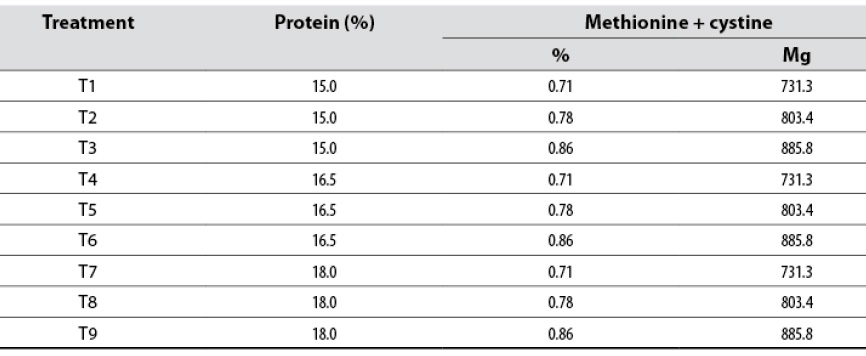
Source: Elaborated by the authors
The experiment was carried out in the laying henhouse, which is 12 m wide, 22.2 m long, and 3.8 m high and has a 0.4 m skylight. The sidewalls are protected with metal mesh and covered with a white burlap curtain to prevent strong winds. The henhouse contained 36 metal cages that were 61 cm long, 50 cm wide, and 31 cm high. Each 508.33 cm2/hen cage housed six layers and was equipped with an automatic drinker and a foil feeder.
The birds were identified and distributed at random in the nine treatments, consisting of four repetitions of six animals each. Nine diets were prepared; the proposed treatments are shown in table 1. For the first factor, protein, and the second factor, methionine-cystine, three different levels were considered. These levels were chosen according to the portion suggested by the genetic house: 90, 100, and 110 g; 18.0, 16.5, and 15.0% protein and 0.71, 0.78, and 0.86% of sulfur amino acids are recommended for each. All diets were isocaloric (2.80 Mcal ME/kg), isocalcium (4.08%), and isophosphorous (0.45% of available phosphorus). Besides, the total amino acid level in the nine formulas was set. For making the formulas, the minimum cost formulation program MIXIT-2 was used. The proximal analysis of the nine diets was carried out (table 2) using the Association of Official Analytical Chemists [AOAC] (1990) method. The birds’ feeding and drinking was ab libitum, daily recording the consumption determined by the difference method of supplied quantity minus residual quantity per day.
Table 2 Experimental diets for layers fed different CP and methionine + cystine (total amino acids) levels
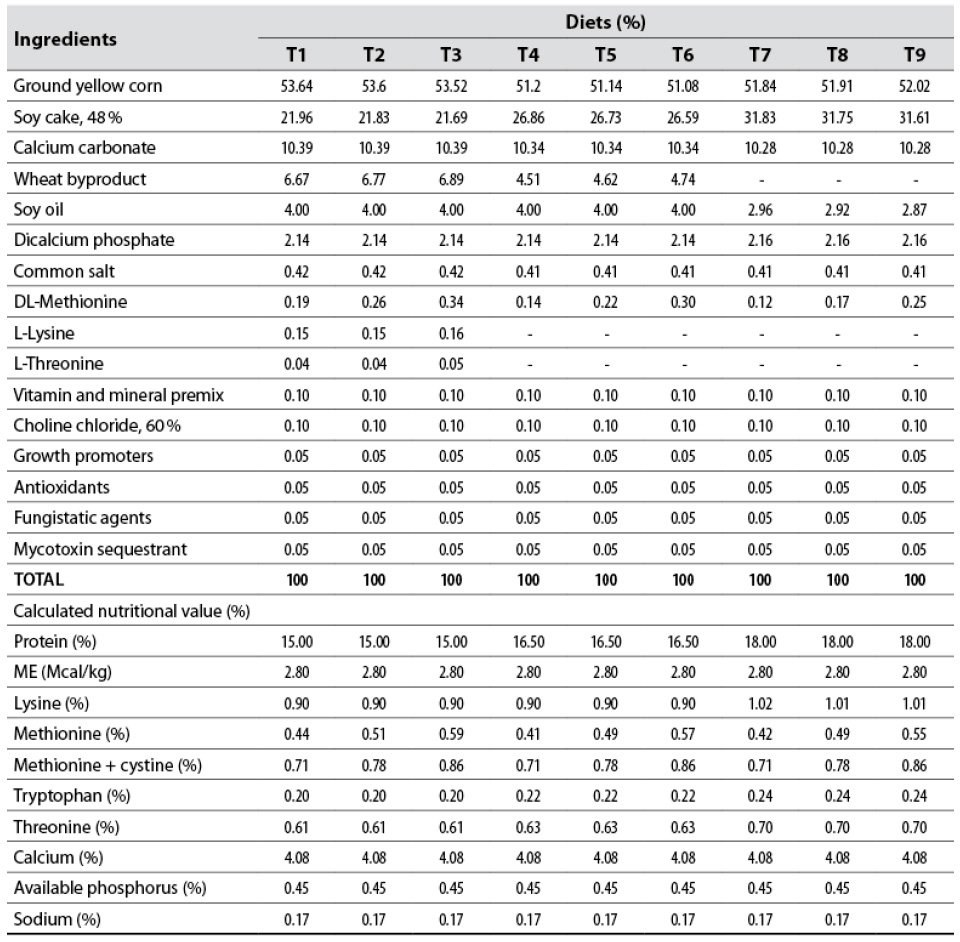
Source: Elaborated by the authors
The chemical analyses of the diets carried out at the UNALM Food Nutrition Testing Laboratory (LENA, for its acronym in Spanish) are shown in table 3.
A 3 (CP levels: 18.0, 16.5, and 15.0%) × 3 (sulfur amino acid levels: 0.71, 0.78, and 0.86%) factorial arrangement was applied within a completely randomized design (CRD) with four repetitions. The experimental unit size was six birds to establish the differences between treatment means using the Tukey test (p < 0.05).
Results and discussion
There were no significant differences in the interaction between protein and sulfur amino acid levels for the egg production variable. Similar results were found by Novak et al. (2006), who reported that reduced protein with proper essential amino acid supplementation did not decrease egg production because the conversion of essential amino acids into non-essential ones was suppressed.
A significant effect (p < 0.05) on the protein level was observed for the egg production variable (table 4), with birds fed 18.0% protein being the ones that obtained the highest production compared to those fed 15% protein. There were no differences either between these two levels compared to birds fed 16.5% protein. These results coincide with those obtained by Bunchasak et al. (2005) and Adeyemo et al. (2012), who found, when testing different protein levels, that the highest laying percentages were obtained with the highest protein levels.
Likewise, Gambaro (2014) observed a reduction in egg production by decreasing CP levels from 17.4 to 15.4. This author suggests the possibility of an interrelation between essential and non-essential amino acids. If not supplied in adequate quantities, non-essential amino acids would have to be synthesized in the body from other amino acids or nutrients present in the portion; so, their deficiency would affect egg production. This decrease in egg production can also be justified by the antagonism between amino acids, commonly occurring in diets with low CP content. When present in high concentrations in the portion, lysine in its free form can compete with arginine for absorption sites, reducing arginine uptake by enterocytes.
No effect of sulfur amino acids (p > 0.05) on egg production was noted. Comparable results were obtained by Liu et al. (2005) and Novak et al. (2006). The Hy-Line Brown management guide recommends 603–747 mg/bird/day of methionine + cystine. On the contrary, Rostagno (2017) suggested the consumption of 880 mg/bird/day. In this experiment, the average consumption was 791 mg/bird/day. The absence of significant effects of methionine + cystine levels may be due to the consumption of sulfur amino acids above the amount indicated in the management guide. In this regard, Pérez-Bonilla et al. (2012) reported that the consumption of sulfur amino acids above the recommended portion does not affect egg production.
There were no significant differences in the interaction between protein and sulfur amino acid levels for egg weight. Put differently, the treatments show similar results, but a significant effect (p < 0.05) of the protein level was observed on the egg weight variable (table 4), being the birds fed a protein level of 15.0% those with higher egg weight in comparison with those to which 18.0% protein was supplied. Moreover, there were no significant differences (p > 0.05) between the CP level of 16.5% and the two levels mentioned above.
These results do not coincide with those of Gambaro (2014), who tested two CP levels and two methionine + cystine levels and found no effect of CP on the average egg weight. However, he did find an effect of methionine + cystine on the mentioned variable. Da Silva et al. (2014) and Rama Rao et al. (2011) noted higher egg weight in the treatments that contained more protein when testing portions with 15.0% and 18.0% protein.
According to Leeson and Summers (2009), egg weight depends on the protein level and energy content in the diet. High protein levels have adverse effects in conditions of heat stress since the bird has to consume energy to eliminate the excess heat generated by protein metabolization. The present experiment was carried out between December and March when the temperature reached up to 33 °C; therefore, the hens on diets with 18.0% protein had to consume energy to dissipate the heat produced in metabolizing the protein, reducing the energy content of the portion and, therefore, the average egg weight. These authors suggested that increased egg weight is associated with the addition of oils to the diet. In the experiment, portions with 15.0% protein had a higher percentage of soybean oil than those with 18.0%, which would explain why the hens that consumed diets with lower protein levels had a higher average egg weight.
Regarding egg mass (table 4), there was no interaction (p > 0.05) between protein and sulfur amino acid levels. These results do not agree with the findings of Silva et al. (2006) and Brumano (2008), who reported that reducing protein levels from 17.0 to 14.0% and methionine + cystine levels from 0.9 to 0.7% reduces egg mass significantly. The egg mass is directly related to average egg weight and the number of eggs produced. While egg production and average egg weight were affected by the protein level when considering these two parameters in calculating the egg mass, no differences were found between the protein levels evaluated. There were no differences in egg mass either compared to the sulfur amino acid levels.
In this experiment, birds fed 18.0% protein produced more eggs but lighter on average than birds fed 15.0% protein, which produced fewer eggs, but heavier. Two factors may be related to this result: heat stress and the lower amount of soybean oil in the diets with 18.0% CP. These factors may cause hens fed 15.0% protein to have eggs with a higher average egg weight than those fed 18.0%, explaining why the protein and sulfur amino acid levels did not significantly affect the egg mass variable.
There were no significant differences (p > 0.05) in feed consumption (table 4) for the treatments, not being influenced by the CP levels, as found by Silva et al. (2006). In this regard, Novak et al. (2006) suggested that the increase in feed consumption occurs only when amino acids, such as lysine, methionine, threonine, and tryptophan, are below the requirements; this was not the case in the present study, which may be the reason the treatments showed very similar consumption. Methionine + cystine levels did not affect feed consumption. These results were like those obtained by Sá et al. (2007) and contrary to those obtained by Brumano (2008). According to Gambaro (2014), the inconsistent results between studies may be related, among other factors, to the composition of experimental diets in terms of amino acid balance. Andriguetto et al. (2003) indicated that the amino acid imbalance in a portion causes specific changes in the concentration of plasma amino acids, affecting the birds’ feed consumption.
Furthermore, the average consumption was 101.04 g, which was below the indications in the Hy-Line guide: 112.00 g. As noted, this study was carried out between December and March, with temperatures up to 33 °C; then, the birds could have been under heat stress. In this regard, Rostagno (2005) considered that energy requirements decrease by 2 kcal of metabolizable energy for each kilogram of live weight and each degree Celsius of increase, from 21 to 27 °C; therefore, the energy requirements decreased by 13.76 kcal, which is why feed consumption decreased.
No significant effects (p > 0.05) of the protein level were observed on the feed conversion variable (table 4). Comparable results were found by Andrade et al. (2003), who guaranteed satisfactory performance by reducing the protein content in the portion from 17.0 to 15.0% with the proper supplementation of lysine and sulfur amino acids. However, in the present study, the birds fed diets containing 0.71% methionine + cystine, that is, 688.89 mg/bird/day, obtained the best feed conversion. Using Hy-Line W-36 hens between 24 and 40 weeks of age with increasing sulfur amino acid levels, Brumano (2008) reported better results for feed conversion from the methionine + cystine level of 0.785%, which corresponds to 694 mg/bird/day, suggesting that the improvement in portion utilization is due to better amino acid balance.
For the weight gain variable (table 5), there were significant differences (p < 0.05) in the interaction between the protein and sulfur amino acid levels. Hens fed a low protein level, even when increasing sulfur amino acid supplementation, did not promote more significant weight gain; however, in birds fed high protein diets, methionine + cystine supplementation increased weight gain.
Table 4 Effect of CP and methionine + cystine levels on the egg production, weight and mass, feed consumption, and feed conversion variables
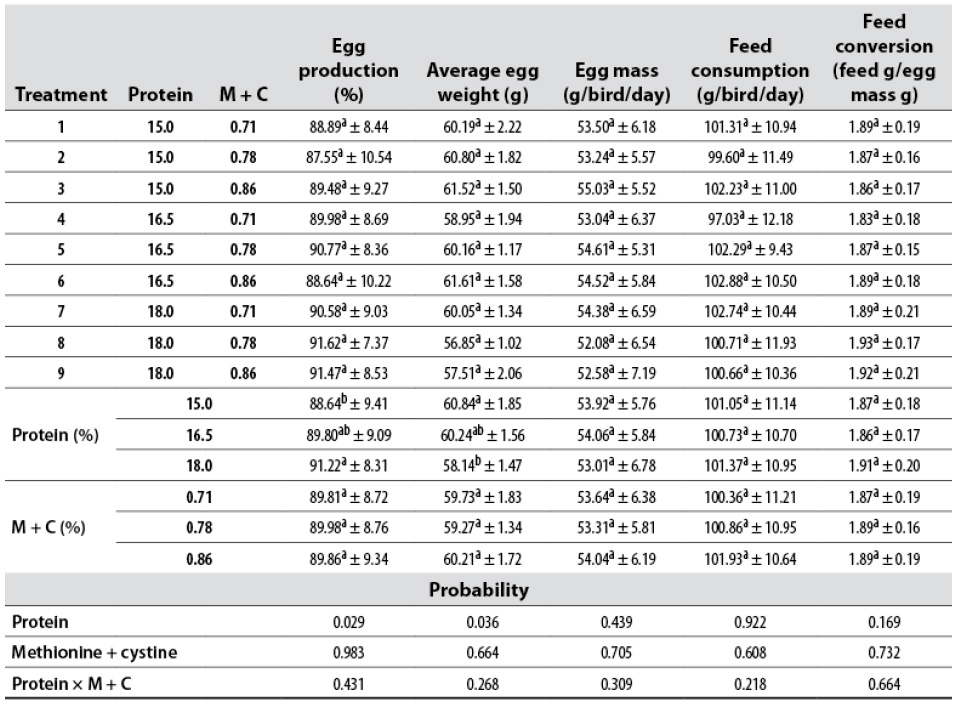
a, b:Different letters indicate a statistical difference (p < 0.05).
Source: Elaborated by the authors
According to Novak et al. (2006), protein and sulfur amino acid levels influence weight gain. Layers fed a lower protein level tend to decrease weight gain because they have a small surplus of this nutrient to store. On the contrary, as birds age, they require more methionine + cystine due to their maintenance role; therefore, the birds subjected to portions with a higher amount of this nutrient obtain greater weight gain. A significant effect of the protein level was observed for weight gain, where the birds fed 15.0% protein exhibited lower weight gain than the hens fed 18.0%.
Similar results were obtained by Da Silva et al. (2014), who also noted a decrease in weight gain by 29.4% when reducing the protein level from 18.0 to 14.0%.
Even though the lower protein levels caused less weight gain, it was identified that all treatments provide daily weight gains higher than those recommended by the guide, which is 0.5 g/bird/day. Likewise, there were significant differences in the methionine + cystine level factor on the weight gain variable, where birds fed 0.86% sulfur amino acids achieved greater weight gain than those fed 0.71%. Comparable results were obtained by Calderón and Jensen (1990), who found that weight gain increases as protein levels and methionine supplementation increase.
Interaction between the sulfur amino acids and protein levels was detected for the final weight variable (table 5). In layers fed low protein diets, increased sulfur amino acid supplementation did not influence final weight; nevertheless, in hens fed high protein diets, methionine + cystine supplementation increased final weight. Accordingly, Faria et al. (2016) reported that methionine and cystine influence the final weight of layers because they are glucogenic amino acids used in the glycogen formation in the liver and muscle by gluconeogenesis; therefore, they directly affect birds’ body recovery.
Table 5 Effect of protein and methionine + cystine levels on initial weight, final weight, and weight gain variables, in addition to Haugh Units (HU) and eggshell thickness in layers
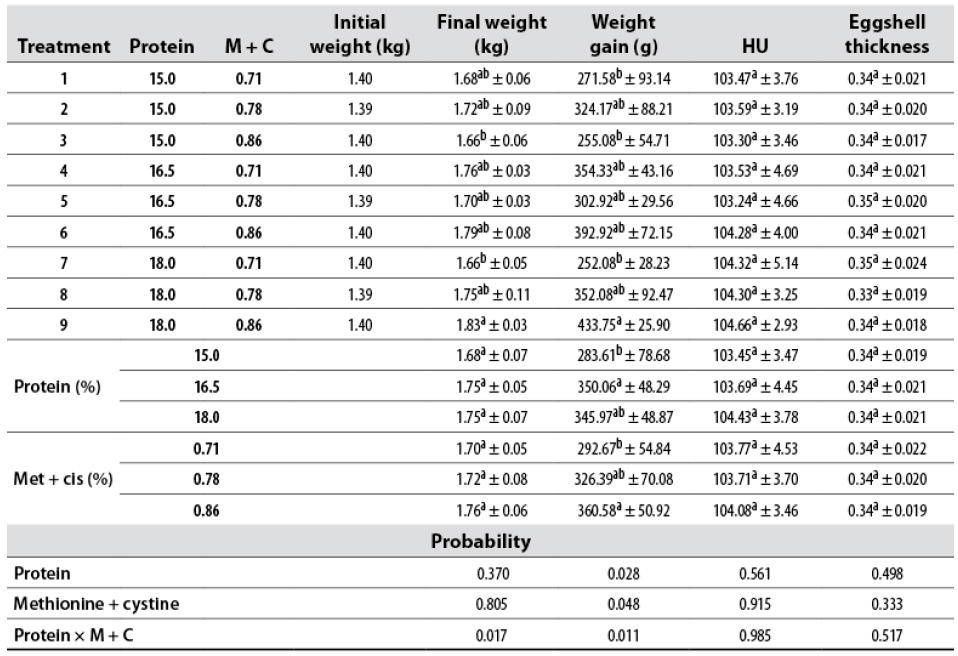
a, b:Different letters indicate a statistical difference (p < 0.05).
Source: Elaborated by the authors
There was no evidence of interaction (p > 0.05) between the protein and methionine + cystine levels, nor separate effects of the two factors on the HU variable (table 5). The general average of the nine treatments was 103.85 HU, a trend similar to that described by Sá et al. (2007), who did not report significant effects for the methionine + cystine levels tested on the HU, finding an average HU value of 95.59.
For eggshell thickness (table 5), there was no interaction (p > 0.05) between the sulfur amino acids and protein levels, nor separate effects of the factors. The mean thickness in this study was 0.34 mm, which agrees with the findings of Novak et al. (2006), who found no significant effects on eggshell thickness when varying the protein and methionine + cystine levels. These researchers reported mean eggshell thickness values of 0.44 mm. However, when testing three methionine + cystine levels (0.75, 0.71, and 0.67%), Gallardo and Tasayco (2016) found significant differences for HU and albumen percentage, but not for eggshell percentage and specific gravity.
Regarding return in egg production (table 6), higher profit is obtained with Treatment 4, followed by Treatment 3. These results are due to these treatments having the lowest feed conversion. Besides, they contain 16.5 and 15.0% protein levels and 0.86and 0.71% sulfur amino acid levels, respectively. Protein is the costliest nutrient in the diet for layers; therefore, portions with 18% of protein were the most expensive. On the other hand, a nutritionist’s strategy to reduce feed costs is to decrease protein levels and supplement them with amino acids.
Conclusions
The birds fed 18% CP showed significantly higher egg production with lower average egg weight than those fed 15.0%. It is possible to reduce the protein levels from 18.0to 15.0% in the diet of birds between 25 and 37 weeks of age using amino acid supplementation with methionine + cystine levels of 0.7%, without impairing layers’ weight gain and final weight.
Additionally, it is possible to reduce the protein levels from 18.0% to 16.5% in the portion supplied to layers between 25 and 37 weeks of age with supplementation of sulfur amino acid levels of 0.7%, without affecting production efficiency and egg quality in Hy-Line Brown hens. Finally, the highest returns were achieved with protein and sulfur amino acid levels of 16.5 and 0.7% or 15.0 and 0.9%, respectively.











 text in
text in 



